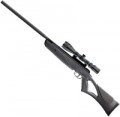Muzzle velocity
The muzzle velocity provided by the rifle - that is, the speed of the bullet as it exits the barrel.
All other things being equal, a higher bullet speed provides greater range and accuracy, and also simplifies aiming at long distances: the bullet flies along a smoother trajectory and requires fewer adjustments in height, and the influence of side winds decreases with increasing speed. On the other hand, this indicator directly affects the price of the rifle; and in some countries, legal restrictions on the ownership of pneumatic weapons are also related to the muzzle velocity of the bullet.
As for specific values, in the weakest modern rifles the initial speed does not exceed
150 m/s, and in the most powerful it can be
300 - 350 m/s or even
more(remember, the speed of sound is 330 m/s). In general, for recreational shooting at short distances, this parameter is not particularly important, and detailed recommendations for choosing pneumatics for more specific situations can be found in special sources. Let us only note that in AEG electric drives (see “Type”) the initial speed extremely rarely exceeds 150 m/s, but this is done solely for safety reasons: such “weapons” are intended for military-tactical games and initially involve shooting at people, and the high speed would be unsafe for players even with protective equipment.
It is also wor
...th considering that this indicator is not strictly defined. In any type of pneumatic it depends on the weight of the bullet (the lighter the faster); therefore, in the characteristics it is usually customary to indicate a certain average velocity for standard ammunition (usually weighing 0.5 g, in AEG - 0.2 g). In addition, in multi-compression rifles the actual speed of the bullet is determined by the degree of inflation, in gas-cylinder rifles it is determined by the ambient temperature, and in PCP models it is possible to achieve higher speeds than declared by replacing the air with a special gas (for example, helium). Nevertheless, this characteristic makes it possible to evaluate the capabilities of the rifle and compare it with other models, including those that differ in type.Swivels
The presence in the design of the rifle
sling swivels — special loops or staples (usually metal) on which the weapon belt is attached. There are usually two such loops — in the front and back of the weapon. In this case, most often the swivels are installed on the underside of the butt and forearm; this design is universal, it allows both right-handed and left-handed people to use the belt with the same comfort. There are also models with a lateral location of the front swivel — usually on the left side of the forearm, under the right-handed hold; however, nowadays in such rifles it is often possible to rearrange the swivel to the other side. So if the pneumatic is bought for a left-hander and it is planned to equip it with a belt, it will not hurt to clarify the features of the sling swivels separately, however, most likely, their design will not create inconvenience.
Parallax setting
The ability to manually adjust the parallax in the complete optical sight of the rifle.
For sights of this type in general, see "Aiming Device". Parallax is a phenomenon that occurs when the shooter's eye is not on the optical axis of the sight (in other words, not strictly in the centre of the eyepiece). In such cases, the reticle in the eyepiece may also shift, and its apparent position may not coincide with the actual aiming point. To eliminate this effect, parallax adjustment is applied.
Any optical sight undergoes such adjustment at the factory. However, the physical features of this phenomenon are such that parallax can only be adjusted for a certain distance to the target; with significant deviations from this distance (more than 30% downward or 60% upward), parallax again begins to appear. So if you plan to use weapons at different distances, then it is best to have a sight on it with manual detuning from parallax. At the same time, it is worth noting that the complete optics in air rifles are usually adjusted to relatively short distances — at which these weapons are used; and deviations from these distances are rarely significant. Therefore, the parallax adjustment in standard pneumatic sights is rare — mainly among powerful long-range models that can deal with a wide variety of distances.

